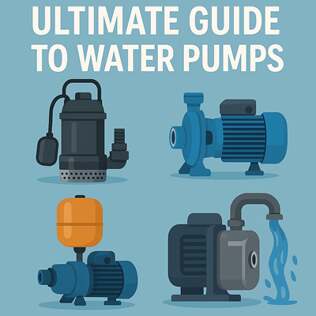Sump Pump for Basements: Choose, Install & Maintain Your Sump Pump
A wet basement can derail a weekend and destroy belongings. A good sump pump is the single best investment to keep your lower level dry, whether you need a basic sump pump basement solution or a more robust water management system. Below I’ll walk you through choosing the right pump, a straightforward install overview, and the maintenance that keeps it working year after year.
Choose the right pump
Most homeowners pick between a submersible pump and a pedestal pump. Submersible pumps sit inside the sump pit, are quieter, and handle solids better; pedestal pumps have the motor above the pit, they’re easier to service and cost less. For typical houses, a 1/3 HP submersible model handles normal storm runoff; choose 1/2 HP or higher if you have heavy inflow, long discharge runs, or deep basements.
Look for specifications that matter: GPH (gallons per hour) at a given head (height), solids handling size, and whether the motor is thermally protected. If you want redundancy, add a battery backup or a secondary pump; that small additional cost can save a lot in a power outage.
Quick install overview (high level)
If you’re comfortable with basic plumbing and wiring, a DIY install is possible; otherwise hire a pro for electrical hookups and to meet local code. Key steps, in plain terms:
- Excavate and set a level, stable sump pit sized to the pump’s recommendations.
- Place the pump on a concrete base or pedestal inside the pit.
- Attach a check valve on the discharge line to prevent backflow.
- Run a 1.5 to 2 inch rigid discharge pipe up and away from the foundation, ending where water can safely drain.
- Plug into a GFCI-protected outlet; battery backup systems require a separate battery and periodic checks.
- Add a sealed cover and an alarm if desired.
Safety note: electrical work should be GFCI protected and follow local rules.
Maintain like a pro
Routine care extends pump life and prevents surprises. Here’s a simple checklist:
- Monthly: Pour a bucket of water into the pit to trigger the pump and verify it runs and shuts off properly. Inspect the float switch for free movement.
- Every 6 months: Clean the pit and remove debris, sludge, or gravel that can jam the pump. Check the check valve and discharge line for clogs and freeze risks.
- Annually: Test any battery backup and replace batteries per manufacturer guidance. Inspect seals, power cord, and motor for wear.
- Replacement: Expect to replace a typical electric sump pump every 7 to 10 years depending on use.
Troubleshooting tips
If the pump hums but does not pump, the impeller may be clogged. If it cycles constantly, the float may be stuck or the pit may be too small. Frozen discharge lines are a common culprit in cold weather; slope the pipe and insulate exposed sections.
A final thought: pumps are part of a broader water strategy that can include French drains, foundation grading, and gutter maintenance. A stout pump buys you peace of mind, but preventing water entry upstream is the real bellwether of a dry basement.

